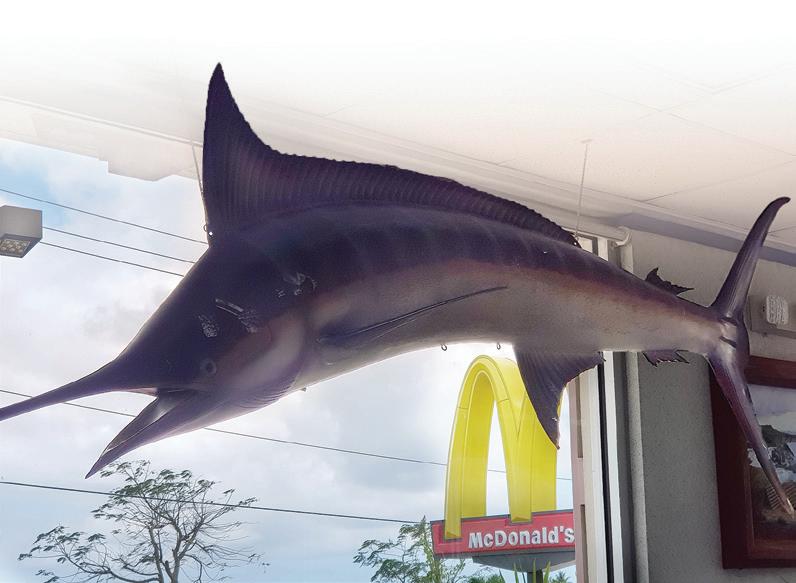
23 minute read
Big Game Fishermen
from Monograph 10 - History of the Billfish Fisheries and Their Management in the Western Pacific Region
2. Big Game Fishermen
The recreational pursuit of trophy billfish such as marlin, spearfish, sailfish and broadbill swordfish is known as “big game fishing.” This sport was helped in its development around 1900 by the creation of specially built fishing boats with inboard engines. (Holcombe 1923).
Advertisement
The social culture of the time embraced big game fishing as an exciting action sport. Anglers used carefully crafted fishing rods and reels with specially made fishing lines and baited hooks to troll for fish behind their boats. Photos of brave anglers standing next to enormous fish caught the world’s imagination. Opinions differ as to when the first marlin was caught by a motor boat. Some say it was in Florida in 1900. However, following the establishment of the Tuna Club of Avalon in California, prominent big game fishermen who knew about the abundance of billfish and tuna in Hawai‘i founded the Hawai‘i Big Game Fishing Club in 1914, the second such club founded globally. The first motorized billfish fishing boat arrived in Hawai‘i in 1916 from San Diego, California.
At the heart of this new sport was then and is today the marlin— beautiful fish, distinct in shape and color, that swim at 50 miles an hour or more among tuna schools, feeding off the tuna as they move beneath the surface. The catching of these large blue and black billfish by means of a lure trolled behind a motor boat produces a sense of euphoria that is difficult replicate in other sports pursuits. During the early part of the twentieth century in the U.S. Atlantic, the catch occurred seasonally. Blue marlin were sought from January to April in the southwest Atlantic and from June to October in the Atlantic northwest, as far south as Florida and as far north as New England. However, marlin are found throughout the world’s seas, and the glamour that surrounded their catch spread as fishermen competed to catch the biggest fish and establish a world’s record.
The sport was immortalized during the 1920s by celebrity writer Zane Grey, who wrote bestsellers such as Tales of Fishing Virgin Seas (1925) and Tales of Tahitian Waters (1931). Images of the sport became a mainstay of popular culture and were featured in Hollywood movies and sports magazines.
Although places such as Key West, Florida, offered atwill sharedcost charters aimed at attracting workingand middleclass participants, the demographics of big game fishing from its start was largely the wealthy and those with high levels of disposable income (Ditton and Stoll 2003). Part of the sport’s appeal was that it emitted highly visible social signals of exclusivity, wealth and success. Men and women alike enjoyed the status and signature branding that came from being photographed standing, usually well dressed and fishing pole in hand, next to a huge blue marlin hanging from a steel hook, the fish dwarfing them in scale.
The sense of accomplishment did not end there. Many of these large trophy fish were cast in sand molds by taxidermists who hand painted them into brilliantly colored lifelike reproductions that could be hung on walls in prominent locations as a tangible symbol of success for everyone to see. This is true even today. Visitors to Saipan who visit the local McDonald’s can admire a 239pound Pacific blue marlin that was caught by the chairman of the McDonald’s Corporation in August 1977 off Honolulu (TutenPuckett et al. 2003). Even after more than 40 years, its shining presence in the store fills visiting customers with awe and demonstrates like a talisman the proud connection between the Saipan McDonald’s and the executive of its parent company.
A number of the big game fishermen of the early sports fishing era went on to participate in exclusive fishing tournaments with friends and family.
Fig. 3. A marlin hangs in the window of the McDonald’s in Saipan, Commonwealth of the Northern Mariana Islands, and another hangs on the restaurant’s wall. One of the marlin was caught by the chairman of McDonald’s Corporation. Photo: WPRFMC.
These tournaments—with their protocols, carefully carved trophies and exotic rituals—were promoted as incentives for wealthy individuals to visit exclusive highend resorts in Florida, Hawai‘i, Cuba and other parts of the world.
Fig. 4. Striped marlin caught by wealthy angler, mid-twentieth century. Photo: Eugene Marie Marron (1957).
The sport also attracted busy executives, who could relax fishing for billfish on a small boat away from the demands of others. Alternatively, they could use the sport as an opportunity for negotiating exclusive business deals while they enjoyed the enhanced privacy the charter boats offered (TBP 2004).
Despite the economic downturn of the Great Depression (1929–1939), which caused many of the lowcost charter boats to go out of business, interest in the sport remained high, and, in 1939, the International Game Fishing Association (IGFA) was established. The IGFA was an organization of likeminded individuals from around the world who supported with annual dues the interests of big game fishermen, established a library and museum, and created protocols for world’s record catches. The last included specifications for the reporting, weighing, certifying and recording of catches.
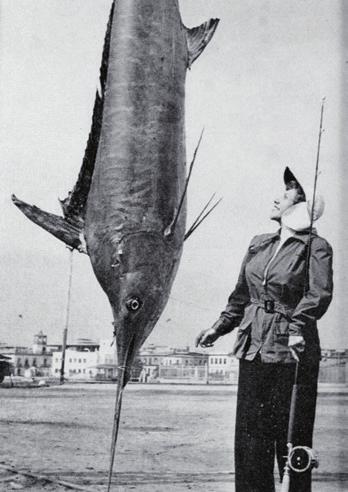
3. Hawai‘i Early Billfish History
Through their international organizations, the big game fishermen of the Atlantic were encouraged to travel the world to catch the biggest marlin. Encouraged by their international social networks, a number of big game fishing celebrities, such as Ernest Hemingway, became interested in Hawai‘i where the largest marlin were caught.
In the desire at the time to catch the biggest, few were troubled that the heaviest and largest fish taken were females. The maximum weight of male blue marlins is 300 pounds and rarely a few pounds more. Thus, they are generally not regarded as trophy fish.
The perceived need to protect and monopolize the biggest fish for the pleasure of their fellow upperclass sports fishermen would put big game fishermen on a collision course with Japanese fishermen who saw marlin and other gamefish as a catch less valuable per pound than tuna but important nonetheless as a source of revenue from fishcake makers. This led to the controversy that followed.

Native Hawaiians used special hooks to catch billfish (a‘u), tuna and other large pelagic fish for hundreds of years from outrigger canoes. The tuna and billfish schools, including those of blue marlin, were abundant and could be found close to shore. As it was among the Europeans and Americans later, the excitement and satisfaction of catching huge, fastmoving fish was considered Fig. 5. Hawai‘i historic flagline/longline vessels were wooden sampans introduced by Japanese such a rare experience that it was fishermen. Photo: NOAA Pacific Islands Fisheries Science Center (PIFSC). reserved exclusively for the ali‘i, the Native Hawaiian nobility. In the early nineteen hundreds, two Billfish such as marlin were especially prized for their long, spikelike events occurred that would change that bills, which, in ancient times, were turned into daggers and swords. perspective. From 1906 onwards, Japanese The ancient Hawaiians knew how to catch billfish in the open sea fishermen were searching the world for and did not anticipate competitors from outside their world coming subsurface tuna schools. Information to fish for them. reached Japan about the proximity of
Fig. 6. Flagline gear included sections of tarred rope. Each section was kept in a basket. Photo: NOAA PIFSC. Fig. 7. Flagline/longline gear includes miles of line kept afloat by buoys. Source: WPRFMC.


bigeye and yellowfin tuna schools lines with baited hooks fastened to the to Honolulu. Soon afterward, mainline descended to depths of 150 a fisherman from Wakayama, to 300 feet. The average number of Japan, came to Hawai‘i to explore hooks was 300 per vessel. The flagline its fishing possibilities. He was could spread for up to 8 miles behind successful, and, in 1917, a fishing the vessel. fleet was developed in Wai‘anae that By changing the depth of the hooks, became the largest source of fresh the fishermen could target different tuna in Hawai‘i (Otsu 1954). species. On average, 7,000 pounds of
This fleet was comprised of 40 to fish were caught per 10day trip, of 63foot motorized wooden sampans, which approximately 25% to 32% was vehicles introduced by Japanese fisher billfish of various kinds, including marlin. In contrast to the relatively few large game fish caught by the troll fishermen in small boats, skilled professional flagline fishermen caught hundreds. The largest flagline fleet was in Honolulu on O‘ahu, but other fleets were based in Hilo and Kona on the Hawai‘i (locally called the Big Island) and in Port Allen on Kaua‘i. The catch of marlin Fig. 8. (Right) Billfish would account for one-quarter to one-third by the local flagline of the flagline catch. Photo: NOAA PIFSC. fishermen was criticized men that would become the standard by visiting recreational fishermen who in the Hawaiian longline industry for feared that the billfish stocks would the next 50 years. The longline fishing be overexploited. The recreational technique imported from Japan was anglers, predominately upperclass known as flagline. The fishing gear Caucasians from the U.S. mainland, included sections of tarred ropes, known did not generally eat the billfish they as “baskets” or “basket gear” as they caught. Instead, they posed with were often stored in baskets. These them for photos. Meanwhile, the local sections were deployed connected to flagline fishermen sold their billfish to each other end to end to constitute a be ground up as fish meal and baked set. Flagged floats were attached at the into kamaboko, or fish cake, which the juncture of each section. Numerous working class plantation workers in Hawai’i during the 1920s and 1930s ate with thin noodles known as saimin. Kamaboko had both economic and political importance. It was one of the principal sources of protein for the plantation workers, many of whom could not afford other kinds of fish.
The dismay that sports fishing writer S. Kip Farrington expressed about the Honolulu fish market of the late 1930s was typical of the mainland writers of his era. He described the sight by saying, “… almost all of the fish brought in [to the fish market in Honolulu] are the magnificent game fish we so much desire to catch on rod and reel. Every morning there will be sampan after sampan tied up at the fishing piers with hundreds of these great fish iced down in their holds” (Farrington 1942). This cultural difference would have longterm political repercussions on billfish policy in Hawai‘i.
Recreational anglers came to Hawai‘i from California in search of blue marlin and giant tuna soon after these species were found in Southern California. Over the next 10 years, Hawai‘i became
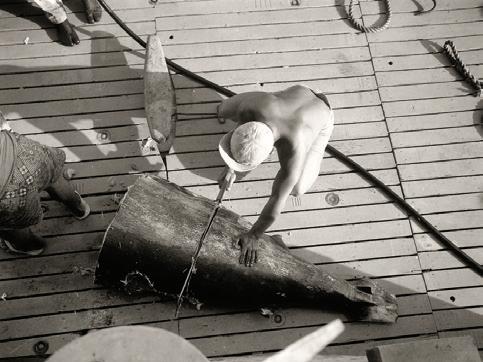
Fig. 9. Kajiki (blue marlin) fillet. Photo: Hawaii Seafood Council.
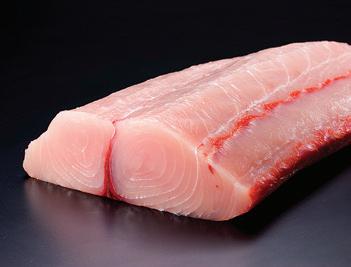
a premier global destination for big game fishing for marlin and other fish. The activity was heavily promoted to visitors who arrived on Matson luxury liner ships and stayed in Honolulu at the worldfamous Royal Hawaiian hotel.
Big game fishing differed in Hawai‘i from other areas on the U.S. mainland. On the mainland, marlin may have been thrown away or sold for cat food after being photographed. However, Hawai‘i sports fishermen knew their crews needed to sell game fish at the local Japanese fish markets to pay their expenses. For this reason, most did not share the antagonism to longliners of their mainland counterparts. Besides, there seemed to be enough fish for everyone.
Likewise, recreational billfish played an important role in local society. Prominent members of Hawai‘i society such as Charles M. Cooke III, cofounder of the Cooke Trust, became involved in the sport and participated
Fig. 10. Ethnic Japanese, working-class women in Honolulu (circa 1930) shopped for items like fish cake to feed their families. Selling fish and fish cake from door to door on the plantation was a form of life insurance for fisherwomen and their families and provided a constant stream of income. If their husband was lost at sea, the family could survive by selling fish provided to them from someone else in their close social network. Photo: Hawai‘i State Archives. Fig. 11. President F. D. Roosevelt offered gifts of octopus (squid) and fish while vacationing in Hawai‘i, July 1934. Photo: Franklin D. Roosevelt Library, National Archives.


in local tournaments. The sport drew wealthy tourists, who looked at big game fishing as something to do in Hawai‘i and who posed with the large fish they caught as mementoes of their trips. The sport became so popular among wealthy visitors that the Kona Inn was built specifically to accommodate these visiting fishermen, who featured among them many famous people including President Franklin Delano Roosevelt.
Recreational billfish fishing also played a part in local business and commerce. Because the Hawai‘i tourism charter boat business was aggressively promoted by mainland writers, business was strong. Skilled boatmen of Japanese, Native Hawaiian, Chinese and Filipino ethnicities could earn significant tips from visitors who had high disposable incomes.
In addition, a small but highly skilled specialty lure business developed. Hawai‘i handmade lures were sold at high prices to sportsmen and fishing stores globally. As with the ali‘i of old, the sport of marlin fishing was reserved for the prominent in Hawai‘i society. Even the boats were moored at yacht clubs, which were privileged retreats for the elite.
Privatecharter trolling boats found at small boat harbors in Honolulu, Maui, Kaua‘i and the Big Island of Hawai‘i catered to both the local elite and mainland visitors. In an effort to please their highpaying clientele who needed to hook up a marlin to be satisfied, charter boat crews developed special knowledge of marlin habits. They caught a disproportionate number of the blue and striped marlin in which their clients were interested. This was especially true off KailuaKona on the Big Island, where ocean eddies create unique currents where marlins tend to congregate (Seki et al. 2002).
Through much of the 1930s, 40s and 50s, the Kona area was known among the world’s billfish enthusiasts as a place where one was likely to catch a “grander,” a large billfish weighing over 1,000 pounds. Each year wealthy fishermen from California, including Hollywood celebrities, would hire famous local fishing boat captains like Henry Chee, whose vessel, Malia, was known as the “Grey Ghost of Kona.” But the fishing trips skippered by Chee and others, such as George Stevens Parker, catered to a small group of very wealthy people and did not have a significant impact on the island’s economy. Only four charter fishing boats worked regularly between 1945 and 1955. They anchored off the
Kona Inn, where deckhands doubled as waiters to drum up fishing clients among the visitors.
For the few charter boat captains, business was difficult. The money they made came from the few tourists and from what they could make driving across the island to sell their fish at the Suisun fish auction Fig. 12. Capt. Henry Chee. Source: IGFA. in Hilo. There were few radios on boats. During the early days, captains like Chee carried pigeons. When he caught a marlin, he would write a note, put it in a capsule, tie it to the bird’s leg and send the pigeon flying to the home of his partner’s wife, Mrs. Charles
Fig. 13. Advertisement for Capt. Henry Chee’s chartered fishing boat service aboard the Malia. Source: Honolulu Advertiser, Sept. 12, 1954.

Findlayson. She would read the note. If it was a big marlin, she would arrange for a photographer. The fish was hung from a hook attached to palm tree in front of the Inn. It was a simple life with the captains living on a narrow margin of income. It may have seemed idyllic to some, but, in fact, it was very stressful. One of the last things Chee said to his wife, before he died of a stroke at age 55 while gaffing a fish, was “Don’t let Butch [their son] fish for a living” (Gutskey 1986).
The island of Hawai‘i lacks beautiful beaches that are large and accessible, and it attracted few visitors during the early years of tourism development. Peter Fithian who arrived in 1955 decided that things could be different. He began promoting the concept to local businessmen that the Kona coast could become a yearround, highend tourism destination if they created a prestigious international fishing tournament (Hogan 1983).
In 1958 he proposed the idea to the director of the Hawaii Visitors Bureau (HVB). The HVB agreed to make up any incurred losses. Support also came from local airlines, Big Island hotels and the Kona Jaycees.
While preparing for the tournament, Fithian discovered the need for billfish research in Hawai‘i. “We had the species all screwed up because we didn’t know one kind of marlin from another and we had different names for them. What was a black marlin, we called silver, and there was no recognition of the Pacific blue marlin. The Hawaiians called all the blues black (marlin)” (ibid). The recordkeeping did not meet IGFA standards. Deciding that the offshore anchorage at the Kona Inn was inadequate for world class destination, he began promoting the idea of a new small boat harbor.
Fithian persevered and ran the tournament out of his office. The first Hawaiian International Billfish Tournament (HIBT) was held in 1959 and attracted 20 Hawai‘i teams, two foreign teams and two U.S. mainland teams. Most of the entrants had their own boats. There were only six or seven charter boats available in Kona for hire.
Fithian spent the next years actively promoting fishing charters in Kona with a travel and booking agency. He introduced a share concept so that a single fisherman could book a place on a charter boat. By making the experience more Fig. 14. Peter Fithian. affordable for Source: Honolulu Advertiser, Nov. 6, 1955. more people, he broadened the potential market for fishing boat captains.
In 1970, his push for a small harbor for Kona was successful. It took about 50 tons of dynamite to blast lava to create the harbor at Honokohau. It was a rough harbor without steps in some places, and people had to jump down from rock walls to get to the boats. However, despite these challenges commercial charter boat fishing in Kona began to grow
By the early 1970s Fithian’s interest in building a reliable database on Hawaiian billfish attracted the attention of John C. Marr, one of the most influential biologists of the era and the former director of the Bureau of Commercial Fisheries (later renamed the National Marine Fisheries Service or NMFS) Biological Laboratory in Honolulu. The Honolulu Laboratory, as it was commonly called, began its work in 1949 under the leadership of Oscar Elton Sette and soon started what would become a long record of advanced tuna and billfish science. During Sette’s time, the lab was known as the Department of the Interior’s Pacific Oceanic Fishery Investigations. Its internationally recognized research in the 1950s included groundbreaking surveys of tunas and billfishes and their pelagic habitat in the equatorial Pacific with the research vessels Smith (which did oceanographic research) and Manning (which did longline gear work).
In the 1979s, NMFS was moving from an approach of fisheries management based solely on catch data by commercial fishermen to one in which models might be used to determine populations on the open sea. There was interest in getting more and new kinds of data based on the life history of fish, e.g., their ages, what they ate, how they reproduced, etc.
This need for improved information for management purposes led Richard Shomura, the director at the time of the Honolulu Lab, to hold the first international symposium on billfish in 1972. The meeting focused on the little known life history of billfishes and included panels of fishermen and scientists, including Fithian, international fisheries author Peter Goadby and Kona captains George Parker and Richard Stroud (Hawaii Tribune Herald 1972).
By 1975, Fithian’s venture was a success. Thousands of visitors were coming to Kona to fish with their families and there were luxury resorts to cater to them. However, as this business developed there was increasing
Fig. 15. Peter Fithian’s news column banner. Source: Honolulu Star-Bulletin, Jan. 21, 1966.
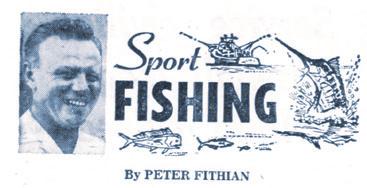
concern that commercial longliners from Japan were taking too many of the large gamefish on the open sea. The presence of these large fish was essential for the new ocean tourism U.S. Bureau of Commercial Fisheries.
It did not take long for the South Atlantic big game fishermen to feel the effects of Japanese longlining. Their catches in the Caribbean Sea off Florida, Cuba and Puerto Rico decreased almost immediately. The results of the Japanese industrial fishing effort would soon be borne out by Japanese fisheries data, which indicated that, from 1958 onwards, the catch per unit effort (CPUE) of blue and white marlin in the Atlantic had decreased from its previous levels (Beardsley 1989).
Atlantic blue marlin commercial catches peaked at 9,000 metric tons luxury market that Fithian and his colleagues had created. If the granders were gone, the business could go too.
To garner the information needed to face this threat, Fithian and Marr formed the Pacific Gamefish Foundation. The foundation supported the work of researcher Charles Daxboeck, whose work in time moved from forensic examination of stomach contents of caught billfish toward eventual state of the art satellite tagging. The foundation eventually became known as the (mt) in 1963 and then dropped to less than 2,000–3,000 mt from 1967 onwards, while white marlin catches peaked at 5,000 mt in 1965 and fell to approximately 1,000 mt by 1977 (Gentner 2007).
A sense of panic set in, reflected in articles in Sports Illustrated: “[The Japanese fishing industry] growth from 1956 to 1963 was astronomical. In 1956, when 164,000 hooks were set by the Japanese, they caught seven metric tons of striped marlin (100 fish) and 50 metric tons of blue marlin (400 fish). By 1963 they had more than 50 million hooks out and
4. Longline Expansion in the Post–World War II Era
Pacific Ocean Research Foundation. Its goals were “Preservation, Knowledge and Management.” The foundation’s independent research and lobbying effort ensured that not all discussion dealing with the future of billfish would be dominated by the commercial fisheries and government fishing administrators. The big game fishing industry, which depended on tourism, would have a seat at the table.
Partly subsidized by the U.S. and Japanese governments in an effort to prevent famine in occupied Japan after World War II, Japanese longline fleets regeared and used their prewar knowledge to search the world’s ocean for tuna. Their quest for yellowfin and other species such as albacore as well as bluefin and bigeye tuna began in the Pacific and, in 1956, extended the Atlantic (NOAA 1978). They set 100 million hooks in a band between 40˚ N and 40˚ S. Fishing fleets from Korea and Taiwan soon followed their example (Beardsley 1989).
Fig. 16. Japanese longliner (circa 1946). Photo: U.S. NOAA NMFS; U.S. Fish and Wildlife Service;

(Hogan 1983) took 8,236 metric tons of striped marlin (126,700 fish) and 9,413 metric tons of blue marlin (75,300 fish). Not to mention countless other billfish and tuna.” (Kane 1966).
The Japanese fleet alone in 1965 set almost 100 million hooks in the Atlantic, catching almost 300,000 marlins according to estimates (NOAA 1978).
Although other countries, including the United States, were involved with bycatch of marlin, Japanese longline fishing vessels became identified in the public mind with the issue of overfishing of the stock. Some of the recreational big game fishermen began to fear that billfish such as blue marlin, white marlin, sailfish and swordfish would be wiped out by 1970. Others, such as Winthrop P. Rockefeller Jr., a founder of The Billfish Foundation (TBF) and later to become governor of Arkansas, were more optimistic and predicted they would last until 2001 (Rockefeller 1989).
The fears of overfishing worsened as 100 to 300 foreign vessels from Russia, Poland, Spain and other nations joined the Japanese and developed factoryfishing industries off American shores: from Florida to Maine on the Eastern Seaboard and from California to Alaska on the West Coast (NOAA op. cit.). Many of these industries used huge drift and drag nets that caught everything in their path, including billfish (Kifner 1974).
Regional Fishery Management Organizations
The U.N. Convention on the Law of the Sea (UNCLOS) codified the rules of international law relating to the high seas. Signed in 1958 and entered into force in 1962, UNCLOS was superseded by UNCLOS III in 1982. Articles 116 to 120 of UNCLOS address the responsibility of states engaged in fishing on the high seas to negotiate with other states fishing in the same area or on the same stock to establish regional or sub-regional fisheries organizations to conserve these living resources. Today, there are about a dozen and half RFMOs globally. Of these, five manage fisheries for tuna and other large species such as swordfish and marlin, covering approximately 91% of the world’s oceans.
The Inter-American Tropical Tuna Commission (IATTC) was established in 1949, primarily to manage bait fish resources for poleandline tuna vessels operating in the Eastern Pacific Ocean. The members of the IATTC are Belize, Canada, China, Colombia, Costa Rica, Ecuador, El Salvador, European Union, France, Guatemala, Japan, Kiribati, Korea, Mexico, Nicaragua, Panama, Peru, Chinese Taipei, United States, Vanuatu and Venezuela. Cooperating nonmembers include Bolivia, Chile, Honduras, Indonesia and Liberia. The focus on baitfish shifted as more industrialized methods of tuna fisheries, i.e., longline and purseseine fishing, became prominent. Further information is available at www.iattc.org.
The International Commission for the
Conservation of Atlantic Tunas (ICCAT)
was established in 1966. ICCAT is involved in management of 30 species, including swordfish, white marlin, blue marlin and sailfish as well as tuna and mackerels. The Commission is currently comprised of 53 contracting parties. The Commission may be joined by any government that is a member of the United Nations any specialized U.N. agency or any intergovernmental economic integration organization constituted by States that have transferred to it competence over the matters governed by the ICCAT Convention.
The Western and Central Pacific Fisheries Commission (WCPFC) was established by the Convention for the Conservation and Management of Highly Migratory Fish Stocks in the Western and Central Pacific Ocean (Honolulu Convention), which was signed in 2000 and entered
Fig. 17. The major regional fishery management organizations that focus on tuna and billfish. Illustration: PewTrusts.org.
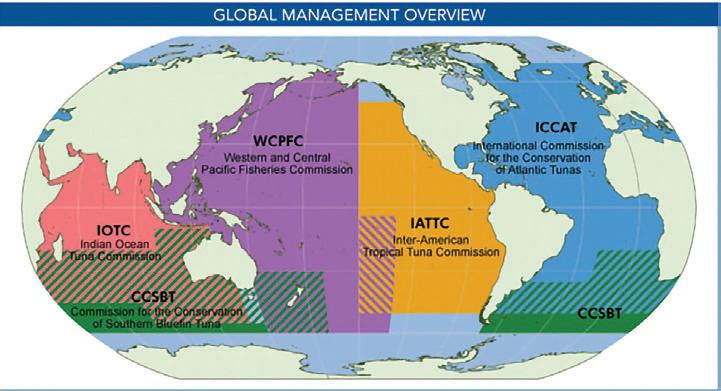
into force on 19 June 2004. The members include Australia, China, Canada, Cook Islands, European Union, Federated States of Micronesia, Fiji, France, Indonesia, Japan, Kiribati, Republic of Korea, Republic of Marshall Islands, Nauru, New Zealand, Niue, Palau, Papua New Guinea, Philippines, Samoa, Solomon Islands, Chinese Taipei, Tonga, Tuvalu, United States of America and Vanuatu. Several French, U.S. and New Zealand territories (American Samoa, Commonwealth of the Northern Mariana Islands (CNMI), French Polynesia, Guam, New Caledonia, Tokelau, and Wallis and Futuna) have a nonvoting seat at the table. Cooperating Nonmembers countries include Curacao, Ecuador, El Salvador, Nicaragua, Panama, Liberia, Thailand and Vietnam. www.wcpfc.int.
The International Scientific Committee for Tuna and Tunalike Species in the North Pacific Ocean (ISC) is the science provider to the members of the Northern Committee of the WCPFC. Membership is contingent on data indicating that fishing by a WCPFC member occurred at latitudes higher than 20˚N. The ISC’s main focus is on North Pacific albacore, Pacific bluefin tuna, blue marlin, swordfish, striped marlin, blue shark and shortfin mako shark. http://isc.fra.go.jp/.
The Commission for the Conservation of Southern Bluefin Tuna was established in 1994 and involves Australia, Japan, New Zealand, Korea, Indonesia, Taiwan, the European Union and South Africa.
The Indian Ocean Tuna Commission was founded in 1996 and is comprised of 31 members, including Indian Ocean coastal countries and countries or regional economic integration organizations that are member of the United Nations or one of its specialized agencies and are fishing for tuna in the Indian Ocean.







